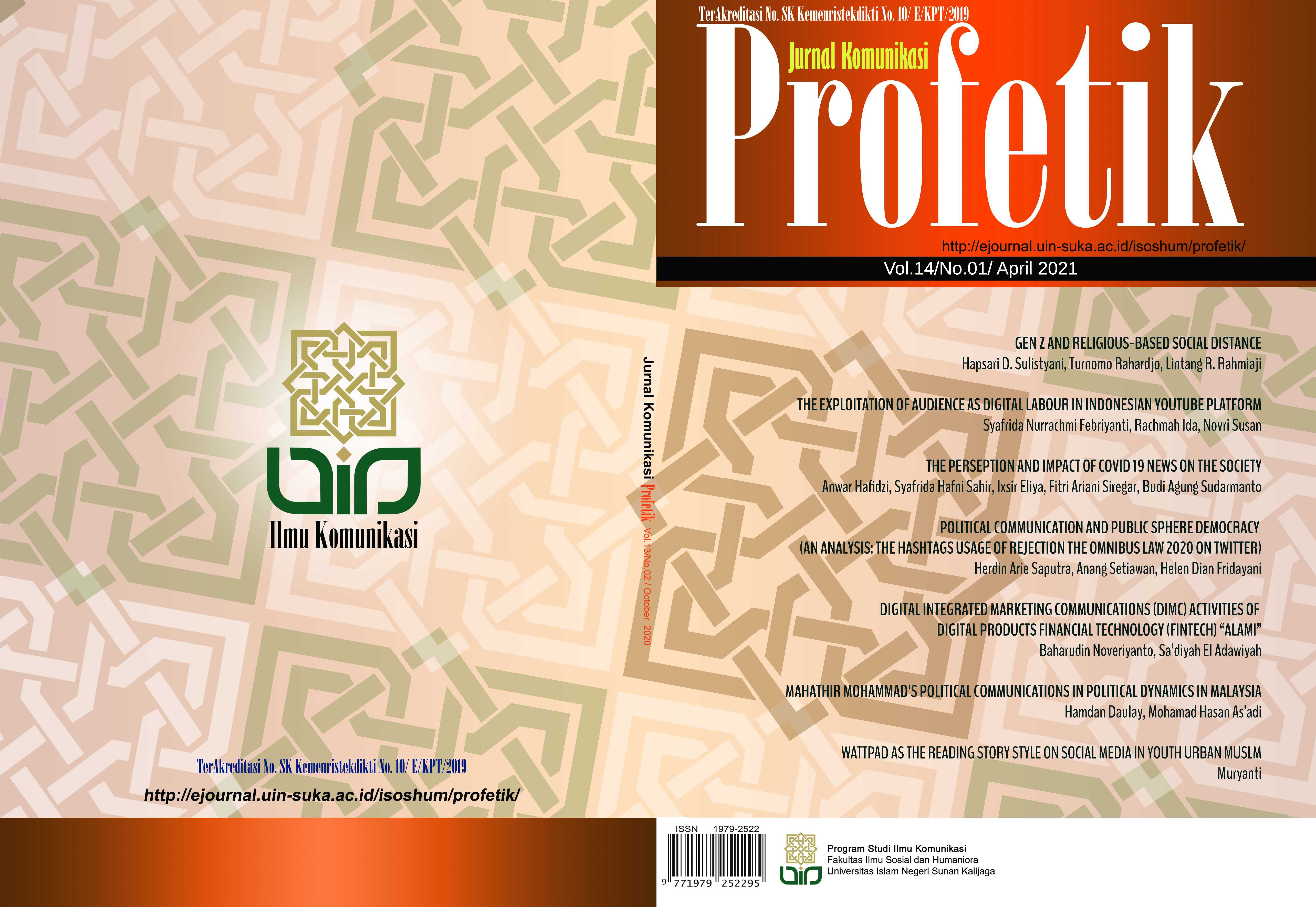BRIDGING CULTURES: INTERCULTURAL COMMUNICATION IN PUBLIC RELATIONS FOR JAKARTA PRACTITIONERS
Main Article Content
Abstract
Article Details
License
Please find the rights and licenses in Profetik: Jurnal Komunikasi by submitting the article/manuscript of the article, the author(s) agree with this policy. No specific document sign-off is required.
1. License
The non-commercial use of the article will be governed by the Creative Commons Attribution license as currently displayed on Creative Commons Attribution-NonCommercial 4.0 International License

2. Author(s)' Warranties
The author warrants that the article is original, written by stated author(s), has not been published before, contains no unlawful statements, does not infringe the rights of others, is subject to copyright that is vested exclusively in the author and free of any third party rights, and that any necessary written permissions to quote from other sources have been obtained by the author(s).
3. User/Public Rights
Profetik's spirit is to disseminate articles published are as free as possible. Under the Creative Commons license, Profetik permits users to copy, distribute, display, and perform the work for non-commercial purposes only. Users will also need to attribute authors and Profetik on distributing works in the journal and other media of publications. Unless otherwise stated, the authors are public entities as soon as their articles got published.
4. Rights of Authors
Authors retain all their rights to the published works, such as (but not limited to) the following rights;
Copyright and other proprietary rights relating to the article, such as patent rights, The right to use the substance of the article in own future works, including lectures and books, The right to reproduce the article for own purposes, The right to self-archive the article (please read out deposit policy), The right to enter into separate, additional contractual arrangements for the non-exclusive distribution of the article's published version (e.g., post it to an institutional repository or publish it in a book), with an acknowledgment of its initial publication in this journal (Profetik: Jurnal Komunikasi).
5. Co-Authorship
If the article was jointly prepared by more than one author, any authors submitting the manuscript warrants that he/she has been authorized by all co-authors to be agreed on this copyright and license notice (agreement) on their behalf, and agrees to inform his/her co-authors of the terms of this policy. Profetik will not be held liable for anything that may arise due to the author(s) internal dispute. Profetik will only communicate with the corresponding author.
6. Royalties
Being an open accessed journal and disseminating articles for free under the Creative Commons license term mentioned, author(s) aware that Profetik entitles the author(s) to no royalties or other fees.
7. Miscellaneous
Profetik will publish the article (or have it published) in the journal if the article’s editorial process is successfully completed. Profetik's editors may modify the article to a style of punctuation, spelling, capitalization, referencing and usage that deems appropriate. The author acknowledges that the article may be published so that it will be publicly accessible and such access will be free of charge for the readers as mentioned in point 3.
References
Beukeboom, C. J., & Burgers, C. (2019). How stereotypes are shared through language: a review and introduction of the aocial categories and stereotypes communication (SCSC) framework. Review of Communication Research, 7, 1–37.
Cutlip, S. M., Center, A. H., & Broom, G. M. (2006). Effective Public Relations (9th ed.). Prenada Media.
Davies, G. (2003). Corporate Reputation and Competitiveness. Rouletdge.
Devito, J. A. (1992). The Interpersonal Communication Book (6th ed.). Harper Collins Publishers.
Fadillah, D., & Wibowo, A. A. (2022). the Fall of Public Relation Officer and the Rise of Influencer in the Indonesian Government. Profetik: Jurnal Komunikasi, 15(1), 19–33.
Farooq, S., Hussain, K., & Rehman, M. (2022). SEARCH Journal of Media and Communication Research.
Goldhaber, G. M., & Barnett, G. A. (1998). Handbook of Organizational Communication. Ablex Publishing Corporation.
Gudykunst, W. B. (2005). Theorizing about intercultural communication. Sage.
Lestari, P. (2007). Stereotip Dan Kompetensi Komunikasi Bisnis Antarbudaya Bali Dan Cina (Studi Di Kalangan Pengusaha Perak Bali Dan Cina). Jurnal Ilmu Komunikasi, 4(1).
Lestari, P., Hendariningrum, R., & Prayudi, P. (2020). Kompetensi Komunikasi Bisnis Lintas Budaya. Jurnal Ilmu Komunikasi, 9(3), 250–265.
Lindlof, T. R. (1995). Qualitative Communications Research Methods. Sage.
Luthfia, A. (2014). Pentingnya kesadaran antarbudaya dan kompetensi komunikasi antarbudaya dalam dunia kerja global. Humaniora, 5(1), 9–22.
Moleong, L. J. (2004). Metode penelitian kualitatif, PT. Remaja Rosdakarya: Bandung.
Moulita, M. (2019). Kompetensi Komunikasi Antarbudaya Siswa Sekolah Menengah Atas. JURNAL SIMBOLIKA: Research and Learning in Communication Study (E-Journal), 5(1), 23–34.
Mulyana. Deddy. (2018). Metodologi Penelitian Kualitatif : Paradigma Baru Ilmu Komunikasi dan Ilmu Sosial Lainnya. PT. Remaja Rosdakarya.
Onganga, J., Abrahams, R., & Makwambeni, B. (2021). The cultural diversity preparedness of public relations students for the public relations industry. Communitas, 26, 152–166.
Rakhmawati, Y. (2019). Komunikasi Fatik Komunitas Public speaking dalam Persuasi Kompetensi Komunikasi. Profetik: Jurnal Komunikasi, 12(1), 74–92.
Samovar, L. A., Porter, R. E., & McDaniel, E. R. (2010). Komunikasi Lintas Budaya (7th ed.). PT. Salemba Humanika.
Schneider, E. J., & Boman, C. D. (2023). Using Message Strategies to Attenuate the Effects of Disinformation on Credibility. Communication Studies, 1–19.
Seidenglanz, R. (2021). The Future of Public Relations as an Organizational Challenge: Topic-Oriented Control, Strategic Integration and Agile Organization in the PR Newsroom. ESSACHESS-Journal for Communication Studies, 14(27 (1)), 93–113.
Sriramesh, K., & Verčič, D. (2002). International public relations: A framework for future research. Journal of Communication Management, 6(2), 103–117.
Sulistyoningsih, S. (2017). Strategi Humas Dan Protokol Terhadap Publikasi Kegiatan Dprd Diy. Profetik, 10(1), 116–129.
Winata, M. D., Wahyuni, J., Setiadi, T., Aji, G. G., & Akhisar, I. (2023). Interpretting Intercultural Communication Approach of Indonesian Diaspora in Turkiye. Profetik: Jurnal Komunikasi, 16(1), 5–21.
Yayu, N., Anisti, A., Hidayat, D., & Suhadi, M. (2019). Pendekatan intercultural communication pada public relations PT Santos dalam membangun komunikasi empati. PRofesi Humas, 4(1), 1–22.
Yin, R. K. (2003). Studi Kasus Desain dan Metode (Terjemahan). Raja Grafindo Persada.
